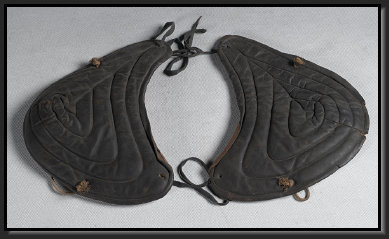In its infancy in the 1870's and 1880's, the game of American football closely resembled it's English ancestor, rugby. Like rugby, the primary means of scoring was through kicking the ball over and between goal posts. A touch-down merely gave a team the opportunity to attempt a goal by place kick. In 1888, three important rule changes were adopted that had a significant impact on the evolution of football. The first permitted offensive players without the ball to use their bodies to interfere with defensive players, who in turn could use their hands and arms to push their way through the offensive line. The second was the introduction of downs. Instead of unlimited tries until possession was lost, a team was given three attempts to gain 5 yards before being forfeiting the ball to their opponents. The third was the awarding of four points for a touchdown, which made it more important than a goal kicked from the field. What all of these rules had in common is that they increased the frequency of player to player contact and made the battle for every inch of the field more desperate and violent. As the rate and force of collisions increased, players began to armor themselves to reduce the risk of injury.

Earliest Forms of Padding
By the mid to late 1890's, players began adding their own homemade padding to uniforms. Cotton batting was sewn into the inside of trousers and cotton and canvas padding was added to the shoulders and elbows of football "jackets" and jerseys. Crude collarbone pads, that were nothing more than a pair of pillows connected together with cord, were worn by some players beneath their jerseys.


Sewn-on Leather Pads
By the turn-of-the-century, equipment manufacturers caught on to the growing trend and began offering leather and canvas pads lined with wool, horse hair, and felt. The pads were then sewn onto the shoulders and elbows of football jackets and jerseys. The first mention of the use of leather shoulder and elbow pads in a Spalding Official Football guide was in 1899 in Walter Camp's "An Introductory Chapter for Beginners."
Spalding No. D. Improved Shoulder Pads, c. 1904-1918 Legendary Auctions, August 2008
Sew-On Leather Shoulder Pads 1898-1918
Sew-On Leather Shoulder Pads Ad, 1908
Player with Sew-On Leather Shoulder Pads, c. 1900-1910
Improved Shoulder Pads
In 1901, the first rigid shoulder pads designed to be worn underneath a jersey were introduced. The No. 25 Improved Sole Leather Pads for Shoulders first appeared in Spalding's Official Foot Ball Guide for 1901 and were advertised again in 1902. The pads consisted of two molded sole leather shoulder cups attached with elastic straps. The pads were held in place by an elastic strap under the arm. In 1903, the Intercollegiate Rules Committee outlawed the use of sole leather in head harnesses and protective equipment. As a result, a new Improved Shoulder Pad, the No. B, replaced the No. 25 in the 1903 Spalding catalog. The No. B, designed by Glenn "Pop" Warner, featured a rigid inner core padded inside and out with wool felt. By 1904 a less expensive alternative, the No. D was introduced.

The "Apparel-Waist"
On April 6, 1900, Joe E. Burns and Abe Schemel applied for a patent for an invention they called the "Apparel-Waist." The invention, which was touted as "new and useful Improvements in Jackets for Foot-Ball Players," was basically a molded or sole leather football "jacket" with articulating shoulder and upper arm guards connected by elastic webbing. No record exists of Burns and Schemel's jacket being sold to the general public, perhaps because it would have been difficult to mass-produce. According to the patent, the jacket was to be adapted "to the form of the body by being molded in a suitably-plastic condition and then permitted to harden and set." The jacket therefore could be manufactured to a given players specifications, but was not adjustable for different body types and sizes.
Chest Padding
Around the same time, players began adding chest protection to their uniforms by sewing leather pads to the center of their jerseys. Often leather thigh pads were used for this purpose given their trapezoidal and rectangular shapes.
University of Chicago Player w/ Chest Pad, c.1900
Reach Shoulder Pad Ad, 1906
Spalding No. 25 Improved Shoulder Pads Ad, 1902
Spalding No. B & D Improved Shoulder Pads Ad, 1906
Early collar-bone padding, c.1898, Legendary Auctions, 2008
Player with homemade shoulder padding, c. 1901
Patent Illustration, Burns & Schemel, Submitted April 6, 1900.
Virginia Agricultural & Mechanical College (later Virginia Tech) Team, 1893
Padding, other than quilted pants, was non-existent.
Padding, other than quilted pants, was non-existent.






Chris Hornung
May 10, 2015
May 10, 2015
Football Shoulder Pad Evolution

Updated: January 15, 2017

